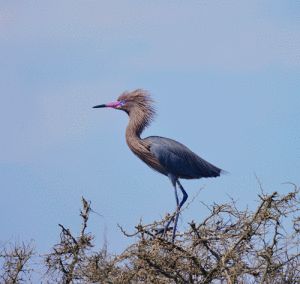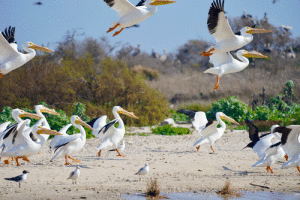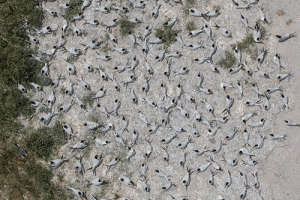
Reddish Egret in Breeding Colors
It is late Spring, and the Colonial Waterbird nesting season is in full swing. And not far from Port O’Connor, nearby Chester Island is covered in birds, nests, eggs and chicks. Much of the year, this island is mostly uninhabited except for a healthy population of Eastern Diamondback rattlesnakes. But from February to September, it becomes home to a great number of nesting Colonial Waterbirds choosing to have their families in this relatively safe environment. In recent years, more than 20,000 nesting pair of 20+ different species take part in this annual migration to nest on Chester Island – with some birds traveling from as far away as Florida and the Mexican Pacific Coast!
You may wonder how all this got started. Chester Island is a man-made island, formed 60 years ago from sand and silt dredged up during the creation of the Matagorda Ship Channel. It didn’t take long for the new island to be discovered by waterbirds, and for them to start nesting on it. Like many other sites along our coastline, Audubon Texas leases this island from the Texas GLO in order to protect the birds that rely on it. With the help of conservation efforts, this low-lying ±70-acre bird island near Port O’Connor has become one of the top 3 largest rookeries along the Texas Coast for Colonial Waterbirds. Local resident Chester Smith managed the island for 25 years as its Audubon Coastal Warden, and his dedicated efforts helped the Brown Pelican population recover from the endangered species list. Also known as Bird Island and Sundown Island, the island was renamed Chester Island in his honor after he passed away in 2011. Coastal Wardens Tim Wilkinson and his wife Peggy (Chester’s daughter) are the current stewards of the island – with tremendous help of many partners and volunteers. They conduct beach cleanup and other projects outside of nesting season. During the nesting season, their main jobs are minimizing disturbance to nesting birds by predators, and by actually counting the birds!
Each year in late May, a Bird Census is conducted on Chester Island in order to determine the current number of nesting pairs of each species. The island is first surveyed aerially from a drone. As the drone flies in a pattern across the island, a high resolution camera pointed downward captures nearly 4,000 high resolution digital images – from which birds and nests are then identified and counted by trained volunteers using computers. The drone survey is then followed by a human survey, where teams of experienced bird counters walk through and count birds in areas with trees and bushes which the drone cannot see through. The results of both surveys are then carefully merged to generate the census results for the entire rookery.
Year round, many forces combine to erode spoil islands like Chester Island, and threaten the bird’s nesting sites. Fortunately for the birds that nest on Chester Island, some of the eastern shoreline was protected many years ago by articulated concrete matting that was placed by the U.S. Army Corps of Engineers. Much of the unprotected shoreline does experience rapid erosion, however this is partly offset by occasional renourishment with additional sand and silt from nearby maintenance dredging operations. Audubon Texas has plans to provide more permanent shoreline protection for Chester Island in the near future, as well as for building additional bird islands in nearby bays, and is securing funding sources for both efforts.
Please be aware that Chester Island is closed to the public, and its nesting birds are protected by federal law. We kindly ask the public to do your part by staying off of Chester Island, and by keeping your distance to avoid disturbing nesting birds – wherever you encounter them. Remember to “Fish, Swim and Play from 50 yards away”.
Birds make Port O’Connor a better place for humans to live and enjoy – and with all of us pitching in, we can help make it a safer place for our birds!
For more info, visit: tx.audubon.org and texanbynature.org/projects/audubon-texas/

White Pelican Visitors on the Beach

Nesting Royal Terns – taken from drone
